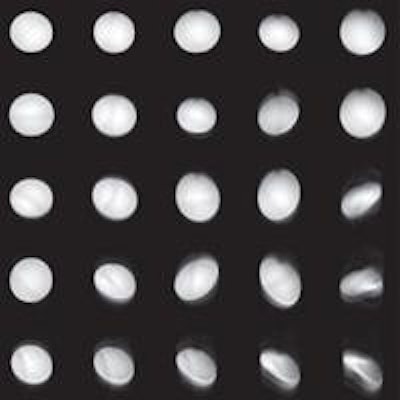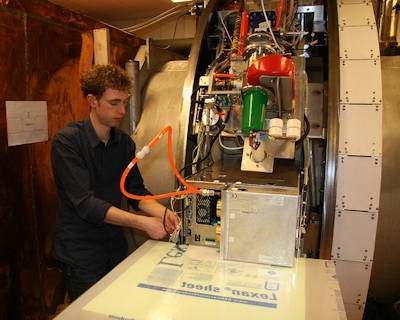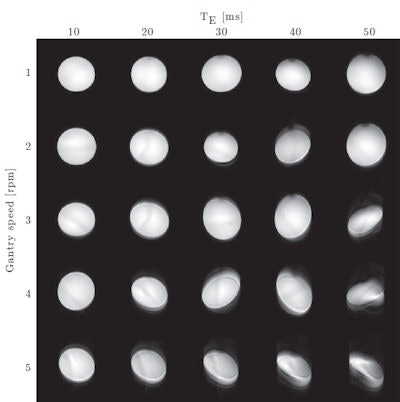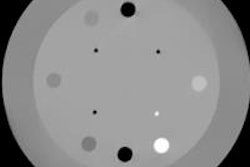
Magnetic field inhomogeneities induced by the close proximity of linac components pose a challenge to the handful of groups developing hybrid MRI-linac systems for cancer treatment. The associated image distortions must be minimized if the full image-guidance potential of the technology is to be realized.
In a new study, researchers in the Netherlands have demonstrated that images acquired with their prototype, which was upgraded with a ring-based gantry, are sufficiently accurate for treatment guidance when the gantry is static. Based at the University Medical Center Utrecht, Sjoerd Crijns, PhD, and Bas Raaymakers, PhD, used measurements of field inhomogeneities to calculate the minimum gradient strength that limits image distortions to less than a millimeter (Physics in Medicine and Biology, 29 May 2014, Vol. 59:13, pp. 3241-3247).
"Although there is a clear influence of that structure on the magnetic field homogeneity inside the scanner, the image quality in terms of geometric fidelity is not degraded, provided that the right imaging parameters are used and the gantry is kept static during imaging," Crijns explained.
 First author Sjoerd Crijns works on UMC Utrecht's MRI-linac prototype.
First author Sjoerd Crijns works on UMC Utrecht's MRI-linac prototype.Shimming minimizes image distortion
In conventional standalone MRI scanners, inhomogeneities caused by nearby ferromagnetic materials, such as iron reinforcements in the floor, are corrected using ferromagnetic plates positioned inside the bore of the scanner -- a form of passive shimming.
For MRI-linacs, active shimming is also required to compensate for variations in inhomogeneity that occur at different gantry angles. The variations result from the movement of magnetic linac components, including those found in the magnetron and RF circulator and are corrected by the scanner gradient coils during the preparation phase of a sequence.
Rotating the gantry while imaging, as would be the case for continuously monitored volumetric-modulated arc therapy (VMAT), adds a further layer of variability to the scanner's magnetic field. In this case, dynamic adaptation of the scanner's magnetic field -- dynamic shimming -- and advanced image reconstruction methods are two ways in which image distortions can be minimized.
Crijns and Raaymakers mapped field inhomogeneities over 72 static gantry positions using a dual-gradient echo sequence applied to a disk-shaped phantom. They acquired data for both shimmed and unshimmed magnetic fields.
Repeated measurements at each gantry angle showed the optimal settings chosen by the scanner produced reproducible magnetic field maps.
 Imaging during gantry rotation revealed increasing distortion as gantry speed and echo time increased.
Imaging during gantry rotation revealed increasing distortion as gantry speed and echo time increased.Submillimeter distortion
Based on the inhomogeneities measured in the field maps, the researchers mapped the minimum readout gradient strength that limited geometric distortions to less than a millimeter. The threshold gradient was calculated as the measured deviation in the magnetic field divided by the maximum image distortion.
The researchers demonstrated that submillimeter image distortions were achievable without shimming with a minimum gradient strength of 15 mTm-1, but this dropped to 10 mTm-1 for the shimmed case, corresponding to higher signal-to-noise ratios. "Stronger imaging gradients are one solution to field inhomogeneity, however, the stronger the gradients, the more noise in the images," Crijns explained.
In a separate experiment, Crijns and Raaymakers investigated the effect of gantry rotation during imaging with a bottle-shaped phantom, testing the MRI-linac for a range of gantry speeds and imaging parameters. The optimal active shim settings from the previous experiment were used. The resulting images were severely distorted, with the distortions increasing as gantry speed and the sequence echo time increased, highlighting the need for dynamic shimming or advanced image reconstruction techniques that mitigate them.
The data acquired by the researchers applies only to their preclinical MRI-linac prototype and the new clinical system under construction at UMC Utrecht is expected to suffer less from gantry position dependent field inhomogeneities. Based on their findings, the group is working on the dynamic shimming and advanced image reconstruction techniques needed to reduce the distortion of images acquired while the gantry is moving. Crijns told medicalphysicsweb that VMAT with continuous MRI monitoring is on the wish list of clinical techniques for the hybrid treatment system.
© IOP Publishing Limited. Republished with permission from medicalphysicsweb, a community website covering fundamental research and emerging technologies in medical imaging and radiation therapy.




















